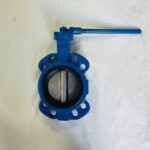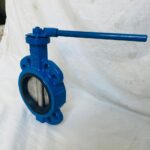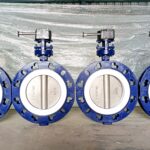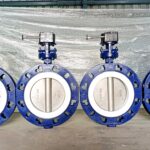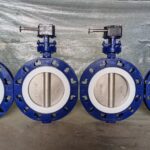Butterfly Valve Centric Design
Embrace the pinnacle of plastics efficiency with Sun Valves High-Quality Butterfly Centric Valve. As a distinguished manufacturer, supplier and exporter, We leads the industry in providing innovative solutions for handling different kinds of liquids which also demonstrates a commitment to technical precision, setting a standard in the field.
Because this compound exceeds industry standards, it offers excellent performance, especially in the demanding processing of plastics. Built for rigorous industrial applications, the premium quality butterfly centric ball valve boasts a robust design that speaks to its durability and its flexibility positions it as the go-to solution for a variety of liquid handling conditions.
Selecting us as your manufacturer of butterfly centric valves opens up a number of benefits. The Centric Butterfly valves are designed and tested and are suitable for variety of liquids and gases in different applications and industries like water applications like agriculture and irrigation facilities water works ,industrial plants, power plants, sewage treatment plants, process industries and chemical and petrochemical plants for tight shut-off and control, Mining, Water supply ,Water treatment ,Sea-water desalination plants, Ship building
Chemical industry, Steel production ,Plants for the production of bio-fuels, Sugar refineries ,Paper production, Food industry, etc
Other than that we also provides customization choices in recognition of the varied demands across different industries and applications. Because of its versatility, it is the best option for handling a variety of applications mentioned above processing difficulties
- Lower Torgue
- Low Torque with any fluid
- Long Service Life
- Greater Sealing Capacity
- Compact space saving design
- Sturdy & robust construction
- Compliance with: IS 13095, AWWA C504, BS 5155 standards
- Bi- directional zero leakage butterfly valve
- Accurate Dual stem sealing and Quarter turn operation for excellence flow control
- Seat integrally molded with the body
- Disc assembly perfectly centered & secured in valve Body bore
- Food Industry
- Industrial plants
- Power plants
- Pharmaceutical Industries
- Sewage treatment plants
- Textile Process Industries
- Chemical and petrochemical Plants
- Mining Industries
Water supply Chains - Water treatment Industry & Plants
- Sea-water desalination plants
- Ship building
- Chemical industry
- Steel production
Plants - Sugar refineries
- Paper production
| Specifications | Details |
|---|---|
| Valve Type | Butterfly Valve, Centric Design |
| Size Range | 2″ to 48″ (DN50 to DN1200) |
| Pressure Rating | ANSI 150, 300, 600, 900, 1500 |
| Temperature Range | -20°F to +350°F (-29°C to +177°C) |
| Body Material | Cast Iron, Ductile Iron, Carbon Steel, Stainless Steel |
| Disc Material | Stainless Steel, Aluminum Bronze, Ductile Iron, etc. |
| Seat Material | EPDM, NBR, FKM, PTFE, Metal Seat (depending on media) |
| Actuation Type | Manual, Pneumatic, Electric, Hydraulic |
| Connection Type | Flanged (RF, RTJ, FF), Lug, Wafer |
| Design Standard | ASME B16.34, API 609, ISO 5752, EN 593 |
| Flow Direction | Bi-directional, Uni-directional |
| End Connection | ANSI B16.5, ANSI B16.10, EN 1092-1, DIN 2532 |
| Seat Design | Soft seat, Metal seat (for high temperature/pressure) |
| Leakage Rate | Class VI (soft seat), Metal Seat: bubble-tight |
| Operation Torque | Dependent on size and pressure rating |
| Test Pressure | Body: 1.5 times the rated pressure, Seat: 1.1 times |
| Flow Coefficient (Cv) | Dependent on valve size and design |
| Face-to-Face Dimensions | According to ANSI B16.10, EN 558-1 |
| Bearing | Self-lubricating, PTFE, or bronze for longer life |
| Special Features | – Quick installation, Low torque requirements |
| – High cycle life, Suitable for throttling and isolation |
Notes:
- Centric Design: The butterfly valve’s disc is centered within the body, with the shaft passing through the center of the disc. This design offers cost-effective construction and simple operation.
- Body Materials: The material selection depends on the application, with stainless steel preferred for high corrosion resistance.
- Seat Material: Soft seats are used for standard applications, while metal seats are utilized for high temperatures or pressures, or in cases where chemical compatibility is required.
- End Connections: Wafer-style valves are the most commonly used for easy installation between two flanges, while lug-style valves allow for disassembly without removing the pipe.
This specification can vary based on the specific requirements of the application, including pressure, temperature, and media compatibility.
Wafer Type Split Body Design Butterfly valve
SUN’s wafer-type split-body butterfly valve is a highly effective valve used for controlling the flow of fluids in a variety of pipeline applications. It combines a compact design with ease of installation, making it a popular choice in industries such as water treatment, chemical processing, and HVAC systems.
Water Treatment:
Commonly used in potable water and wastewater pipelines.
HVAC:
For air flow control and fluid regulation in heating and cooling systems.
Chemical Processing:
For handling corrosive and aggressive chemicals.
Mining and Industrial Applications:
Often found in systems handling slurries or abrasive fluids.
Compact Design:
The wafer-type design reduces the weight and space required for installation, making it ideal for constrained spaces.
Ease of Installation:
These valves can be quickly and easily bolted between flanges, requiring fewer bolts than other valve types.
Cost-Effective:
Wafer-type valves generally have a lower cost due to their design, making them a budget-friendly solution.
Maintenance:
The split-body design makes the valve easier to maintain, with simplified access to internal components.
Versatility:
They are used in a variety of industries, from water treatment to HVAC systems.
Valve Size:
Typically ranges from 1″ (25mm) to 48″ (1200mm), with larger sizes available for specialized applications.
Pressure Rating:
PN10 (10 bar / 145 psi), PN16 (16 bar / 232 psi), PN25 (25 bar / 365 psi)
ANSI 150 (150 psi), ANSI 300 (300 psi), depending on the material and design.
Temperature Range:
Rubber-lined valves: Typically range from -10°C to 80°C (14°F to 176°F).
Metal-seated valves: Can operate from -50°C to 450°C (-58°F to 842°F), depending on the material.
Materials of Construction:
Body Materials:
Cast Iron, Ductile Iron, Stainless Steel (304, 316), or Carbon Steel.
Disc Materials: Stainless Steel, Aluminum Bronze, or similar corrosion-resistant alloys.
Seat Materials: EPDM, NBR, PTFE, Viton, or Metal (for high-temperature applications).
Stem: Stainless Steel or Brass, depending on the requirements.
Actuation:
Manual Actuation:
Lever or gear-operated for smaller or larger sizes.
Automated Actuation:
Available with electric, pneumatic, or hydraulic actuators for remote control or automatic operation.
Sealing
Type:
Soft Seated (EPDM, NBR, PTFE) for standard applications. Metal Seated for high temperatures and abrasive media.
End Connections:
Wafer design allows installation between flanged pipe sections, reducing installation time and complexity.
Leakage Rate:
Class VI (bubble-tight) for soft-seated valves.
Class V or Class VI for metal-seated valves.
Flow Characteristics:
Linear flow characteristics are typical, meaning the flow rate is proportional to the valve opening. Some valves may feature equal percentage or on/off control.
Compliance & Standards:
Manufactured to meet standards such as ISO 9001, CE Marking (EU), and API 609 for design, testing, and manufacturing.
A wafer-type butterfly valve is distinguished by its body design, which does not have flanges. Instead, the valve is sandwiched between two flanges in the piping system. This design simplifies installation and reduces the space required for the valve.
Split-Body Construction:
The split-body design allows the valve body to be separated into two parts, facilitating easier maintenance and repair. This design enhances the durability and the sealing ability of the valve, especially in high-pressure systems.
Butterfly Valve Mechanism:
The valve features a rotating disc (resembling a butterfly), which controls the flow of fluid by rotating around its axis. In the open position, the disc aligns with the flow path, allowing fluid to pass. When the valve closes, the disc rotates 90 degrees to obstruct the flow.






